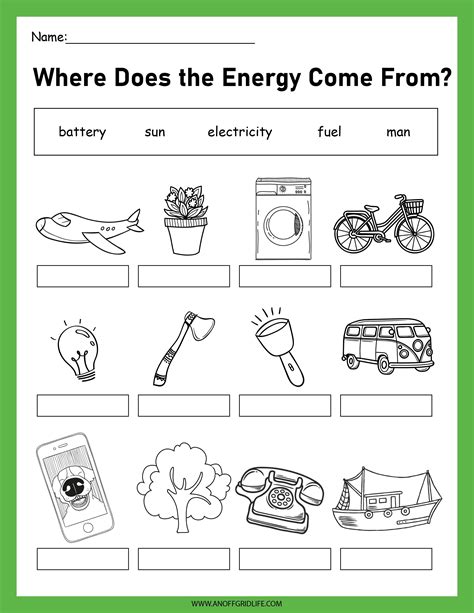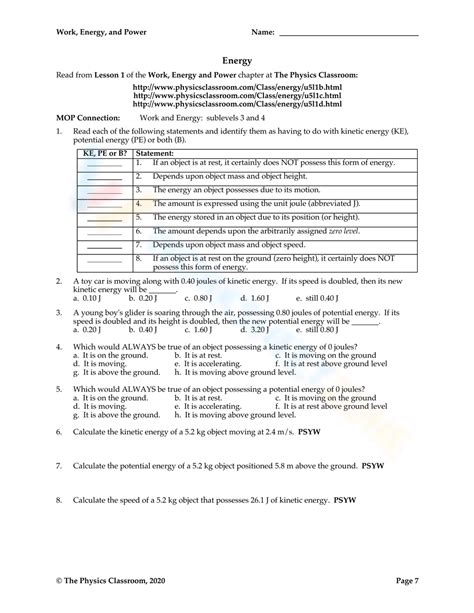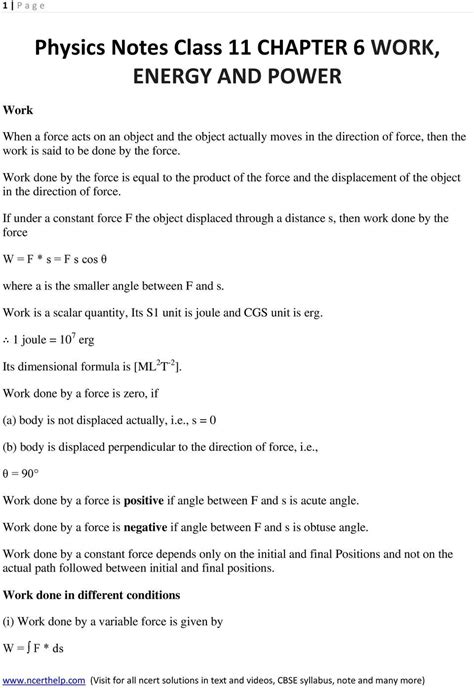Understanding the concepts of power and energy is crucial in various fields, including physics, engineering, and technology. These concepts are often used interchangeably, but they have distinct meanings and applications. Power refers to the rate at which energy is transferred or converted, while energy is the capacity to do work. In this article, we will delve into the world of power and energy, exploring their definitions, types, and applications, as well as providing worksheets to help reinforce understanding.
Key Points
- Definition and distinction between power and energy
- Types of energy, including kinetic, potential, thermal, and electrical energy
- Power calculations and units, such as watts and horsepower
- Energy conversion and efficiency, including examples and applications
- Real-world scenarios and case studies illustrating power and energy concepts
Understanding Power and Energy

Power is typically measured in watts (W) or horsepower (hp), while energy is measured in joules (J) or other units such as kilowatt-hours (kWh). The relationship between power and energy is given by the formula: power (P) = energy (E) / time (t). This formula highlights the importance of time in determining the power required to perform a certain amount of work. For instance, a high-power device can complete a task quickly, while a low-power device may take longer to achieve the same result.
Types of Energy
Energy comes in various forms, each with its unique characteristics and applications. The main types of energy are:
- Kinetic energy: the energy of motion, which depends on an object’s mass and velocity
- Potential energy: the energy an object possesses due to its position or configuration, such as gravitational or elastic potential energy
- Thermal energy: the energy associated with an object’s temperature, which can be transferred through conduction, convection, or radiation
- Electrical energy: the energy carried by moving charges, such as electrons in a conductor
Understanding these types of energy is essential for designing and optimizing systems that convert or transfer energy efficiently.
| Energy Type | Description | Examples |
|---|---|---|
| Kinetic Energy | Energy of motion | Rolling balls, moving cars, flowing water |
| Potential Energy | Energy due to position or configuration | Water stored behind a dam, compressed springs, elevated objects |
| Thermal Energy | Energy associated with temperature | Hot water, heated air, combustion reactions |
| Electrical Energy | Energy carried by moving charges | Electric currents, batteries, generators |

Power Calculations and Units

Power calculations involve determining the rate at which energy is transferred or converted. The formula for power is: P = E / t, where P is the power, E is the energy, and t is the time. For example, if a device uses 100 J of energy in 10 seconds, its power consumption is 10 W. Understanding power calculations is vital for designing and optimizing systems that require specific power levels.
Energy Conversion and Efficiency
Energy conversion refers to the process of changing energy from one form to another. Energy efficiency, on the other hand, is a measure of how much of the input energy is converted into useful work. For instance, a light bulb converts electrical energy into visible light and heat, with a certain percentage of the input energy being lost as heat. Improving energy efficiency is essential for reducing energy consumption and mitigating environmental impacts.
Real-world scenarios and case studies can help illustrate the concepts of power and energy. For example, a solar panel converts sunlight into electrical energy, which can then be used to power devices or stored in batteries for later use. Similarly, a car engine converts chemical energy from fuel into mechanical energy, which propels the vehicle forward.
What is the difference between power and energy?
+Power refers to the rate at which energy is transferred or converted, while energy is the capacity to do work. Power is typically measured in watts (W) or horsepower (hp), while energy is measured in joules (J) or other units such as kilowatt-hours (kWh).
What are the main types of energy?
+The main types of energy are kinetic energy, potential energy, thermal energy, and electrical energy. Each type of energy has its unique characteristics and applications.
How is energy efficiency calculated?
+Energy efficiency is calculated by determining the ratio of useful work output to the total energy input. It's typically expressed as a percentage, with higher values indicating greater efficiency.
In conclusion, understanding power and energy is essential for designing and optimizing systems that convert or transfer energy efficiently. By recognizing the different types of energy, calculating power levels, and improving energy efficiency, we can reduce energy consumption and mitigate environmental impacts. The concepts of power and energy have numerous real-world applications, from solar panels and car engines to light bulbs and electrical devices. By applying these principles, we can create more efficient, sustainable, and environmentally friendly systems that benefit society as a whole.



